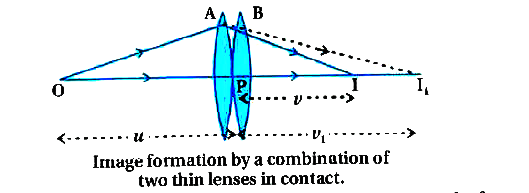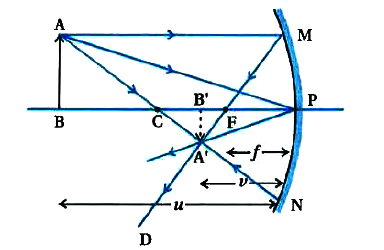Obtain the equivalent focal length of combination of thin lenses placed in contact, Solution in Gujrati

Consider two lenses A and B of focal length f1 and f2, placed in contact with each other.
Let the object be placed at a point 0 beyond the focus of the first lens A.
The first lens produces an image at I1,. Since image I1, is real, it serves as a virtual object for the second lens B producing the final image at I.
Formation of image by the first lens is presumed only to facilitate determination of the position of the final image. In fact, the direction of rays emerging from the first lens gets modified in accordance with the angle at which they strike the second lens.
Since the lenses are thin, we assume the optical centres of the lenses to be coincident. Let this central point be denoted by P.
For the image formed by the first lens A,
1v1−1u=1f1 ... (1)
For the image formed by the second lens B,
1v−1v1=1f2 ... (2)
Adding equation (1) and (2),
1v−1u=1f1+1f2 ... (3)
If the two lens system is regarded as equivalent to a single lens of focal length f we have,
1f=1f1+1f2
The derivation is valid for any number of thin lenses in contact. If several thin lenses of focal length f1,f2,f3,...fn In are in contact, the effective focal length of their combination is given by,
1f=1f1+1f2+1f3+...
Topper's Solved these Questions
- BOOK - KUMAR PRAKASHANCHAPTER - RAY OPTICS AND OPTICAL INSTRUMENTSEXERCISE - SECTION - A (TRY YOURSELF)74videos
RAY OPTICS AND OPTICAL INSTRUMENTS
- BOOK - KUMAR PRAKASHANCHAPTER - RAY OPTICS AND OPTICAL INSTRUMENTSEXERCISE - SECTION-B (NUMERICALS)(NUMERICAL FROM TEXTUAL ILLUSTRATIONS)17videos
RAY OPTICS AND OPTICAL INSTRUMENTS
- BOOK - KUMAR PRAKASHANCHAPTER - MOVING CHARGES AND MAGNETISMEXERCISE - SECTION D (MCQs ASKED IN COMPETITIVE EXAMS)34videos
MOVING CHARGES AND MAGNETISM
- BOOK - KUMAR PRAKASHANCHAPTER - SAMPLE QUESTION PAPER EXERCISE - PART-B SECTION-C5videos
SAMPLE QUESTION PAPER
Similar Questions
Give range of wavelength of visible light.
02:04View SolutionSuppose that the lower half of the concave mirror.s reflecting surface as shown in figure is covered with an opaque (non-reflective) material. What effect will this have on the image of an object placed in front of the mirror ?
 06:22View Solution
06:22View SolutionElectric charge Q having mass M moves on a circular path of radius R with velocity →v, perpendicular to uniform magnetic field B. When a particle completes one revolution, work done by the field is _______
02:34View SolutionTwo charges –q and +q are located at points (0, 0, –a) and (0, 0, a), respectively.
(a) What is the electrostatic potential at the points (0, 0, z) and (x, y, 0) ?
(b) Obtain the dependence of potential on the distance r of a point from the origin when r/a>>1 .
(c) How much work is done in moving a small test charge from the point (5,0,0) to (–7,0,0) along the x-axis? Does the answer change if the path of the test charge between the same points is not along the x-axis?05:25View SolutionObtain an expression for focal length of a combination of thin lenses in contact.
05:25View SolutionObtain an expression for the combined focal length for two thin convex lenses kept in contact and hence obtain an expression for the combined power of the combination of the lenses.
02:03View SolutionObtain the formula for combined focal length of two thin lenses in contact, taking one divergent and the other convergent.
02:28View SolutionDerive the expression for effective focal length of two thin lenses kept in contact.
06:01View SolutionDerive the expression for effective focal length of two thin lenses kept in contact.
03:22View SolutionTwo thin lenses of focal lengths 20 cm and 25 cm are placed in contact. The effective power of the combinations is
10:21View SolutionTwo thin lenses of focal lengths 20 cm and 25 cm are placed in a contact. The effective power of the combination is
01:49View SolutionCombination of lenses are used in optical instruments to obtain the required power. Obtain an expression for the effective focal length of the combination of two thin convex lenses in contact.
02:21View SolutionDerive the expression for the equivalent focal length of a combination of two thin convex lenses in contact.
View SolutionDerive an expression for the equivalent focal length for two thin convex lenses in contact.
View SolutionTwo thin lenses of focal lengths 20 cm and 25 cm are placed in a contact. The effective power of the combination is
02:53View Solution

